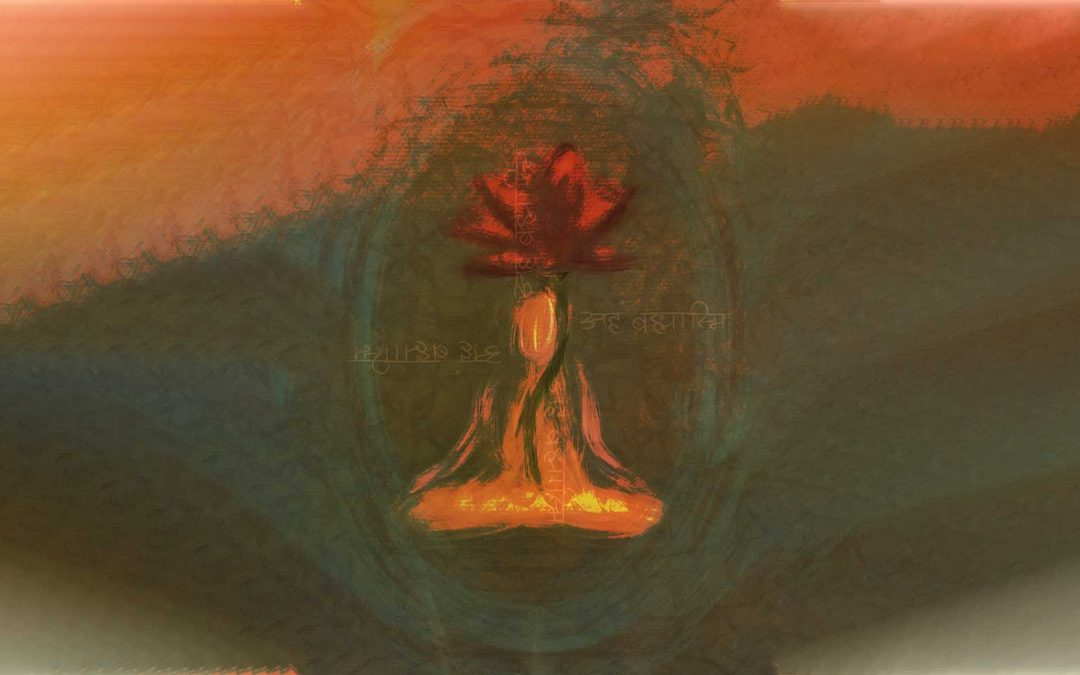
Roots & Evolution of Mantra Based Auto Transcending Meditation (MB-AST)
Meditation is known as a technique to calm the mind and improve mental health, though many don’t know the origins of meditation or what happens to the mind when you meditate. There are many different techniques of meditation, and the teaching methods of each have changed throughout the years. If you look into the history of meditation, you will find that every meditation technique has beginnings in Eastern tradition.
Meditation has been studied and practiced for thousands of years, and its techniques have roots in both Dualism and non-dualism Philosophies of mind. The dualism theory lies in the idea that the mind and physical body are very different, and that they cannot be treated similarly. non-dualism theory lies in the belief that a person is neither their physical body nor their mind, a person is something else, which non-dualism calls Pure Consciousness.
Roots of meditation can be found in both Vedic/Indian traditions and Buddhist. Buddhist meditation practices focus on different ways to engage the mind in meditation. Vedic/Indian Traditions focus on the experience of content-free awareness, where you are not actively engaging the mind. Content-free awareness is also called the state of Yoga or Samadhi.
Vedic/Indian meditations have been passed down through generations. The most popular Non-Dual meditation has become Mantra Based Automatic Self Transcending (MB-AST) meditation.
To see how this technique is used today and how it can affect our mental health, we have to start from the beginning.
Beginning of Meditation
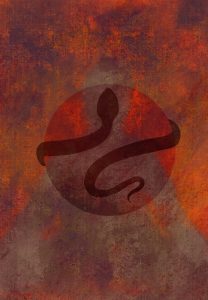
The earliest found records of any meditation date back to about 1500 years BCE (Before Common Era). Chinese Taoist and Indian Buddhist traditions developed their own types of meditation in the 6th-4th centuries BCE. Philo of Alexandria and the Desert Fathers of the Middle East were developing their own forms of meditation.
Mantra Based Automatic Self Transcending (MB-AST) meditation started in the Vedic Era, or Vedic age (c. 1500 – c. 500 BCE). It was shared by word of mouth and with literary texts that are now the earliest evidence of modern-day Indian culture. These literary texts are collectively called the Vedas and include the:
- Rig
- Sama
- Yajur
- Atharvaveda
These four texts were written in archaic ( or Vedic Sanskrit) and were dated between 1500 and 800 BCE. These texts focus on how there is a single, infinite and indivisible reality, whose nature is pure consciousness, from which all objects and selves derive their apparently independent existence. Non-dualism and meditation can help you access it. Towards the end of the Vedic age, another text called the Upanishads became widely known. While the Upanishads were once considered a part of the Vedas, they became their own separate text outside of the Vedas. From the Vedas, many influencers arose to further teach and expand the idea of non-dualism / meditation.
Influencers #1 of MB-AST
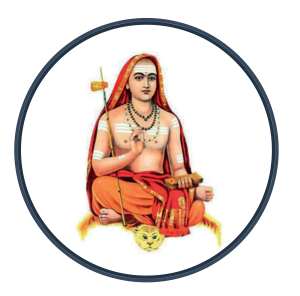
Adi Shankaracharya
Adi Shankaracharya lived about 1,200-1,300 years after Buddha when the Vedic worldview started to shift, straying away from its core values. In Adi Shankaracharya’s time, people were performing demeaning rituals, were very superstitious, and were misinterpreting scripture in ways that stripped away the main message of non-duality. This is why Shankara started to teach the true essence of non-dualism, or Advaita Vedanta.
Shankara taught the Vedas’ core idea that there is an individual spirit, called the Atman, and a universal spirit called the Brahman. He taught that these two spirits should be unified. He expanded his teaching to include Advaita Vedanta (non-dualism) and the Upanishads.
Shankara is probably best known for his teachings of non-dualism and the Smarta. The Smarta teachings showed how different belief systems can work in harmony and how there is compatibility with every belief.
He then created four monasteries or Maths that would help share his teachings across India. These four monasteries were formed in 700 AD, in four different corners of India. Shankara picked 4 people to teach at each Maths. These teachers were called Shankaracharya or “think The Pope” of the Advaita Vedanta philosophy & teachings. Shankaracharyas taught the Vedas’ teachings to the Math’s community and kept Shankara’s core values alive.
These four maths went on to popularize Shankara’s teachings, but by the mid 18th century, the teachings of the Vedas regressed. By 1776, the general population did not actively use the Maths, and people began to farm on the maths land. Finally, in 1941, a new Shankaracharya was appointed. This teacher was called Swami Brahmananda Saraswati, or “Guru Dev”
Influencer #2 of MB-AST
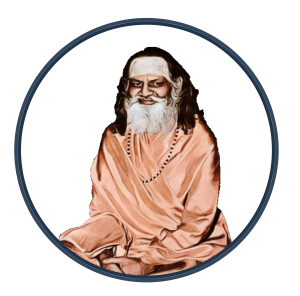
Swami Brahmananda Saraswati “Guru Dev”
Swami Brahmananda Saraswati or “Guru Dev” lived an unconventional life in the 20th century. He was a celibate and lived isolated in the forest and jungles for most of his life. He lived like this until his Guru, Shri 108 Dandi Swami Ji Krishnanand Saraswati, told him to live near towns and civilization.
Guru Dev shortly after assimilated to living in towns, and he became well known for his spirituality. This reputation led to his nomination of the next Shankaracharya of Jyotir Math (one of Shankara’s monasteries). Guru Dev was appointed the head of Jyotir Math after a 165-year gap in leadership, as he was the first one seen as capable for the role in almost two centuries.
Guru Dev taught at Jyotir Math for 11 years, sharing the same core concepts of non-dualism and the Vedas. After teaching for 11 years, a student named Mahesh Prasad Srivastava became Guru Dev’s personal secretary. Swami Brahmananda died on On May 20th, 1953. Shortly after, Mahesh Prasad Srivastava left the Joytir Math to become Maharishi Mahesh Yogi or “MMY”.
Influencer #3 of MB-AST
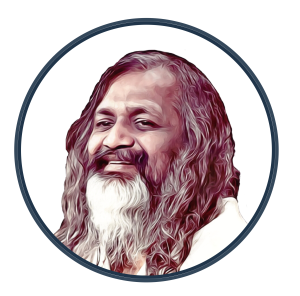
Maharishi Mahesh Yogi (MMY)
Maharishi Mahesh Yogi worked under Guru Dev but did not stay at the Joytir Math after Guru Dev’s passing. Within a decade of Guru Dev’s death, MMY went to Hawaii. MMY wanted to try and spiritually regenerate the world. He taught that people could reach their full potential when they found enlightenment, and people would reach enlightenment with his meditation. As he spent time in Hawaii, the Honolulu Star-Bulletin talked about him, reporting “He has no money, he asks for nothing.” His only mission was to Spiritually Regenerate the World.
MMY’s teachings gained popularity, and TIME wrote about his meditation, calling it a “drugless high” in 1975. People like The Beatles looked to MMY for help handling their newfound stardom, and Mia Farrow looked for guidance after her divorce from Frank Sinatra.
MMY was named “the groovy guru” thanks to TIME, and he credited Swami Brahmananda Saraswati or “Guru Dev” as his inspiration behind his meditation technique. MMY shared that since the death of his Guru, he was on a mission to spread Guru Dev’s teachings. Meditation researchers today call MMY’s meditation techniques Mantra Based Automatic Self Transcending (MB-AST) meditation.
Meditation Techniques of Guru Dev and MMY

MMY’s meditation techniques gained so much popularity that even The Beatles used them to relax. So, what exactly is the technique that gained attention worldwide? Guru Dev and MMY’s meditation techniques are rooted in the same idea of non-dualism, but MMY changed the method a bit as time went on.
Guru Dev’s Technique

Guru Dev advocated the worship of a variety of gods (Bhagavan). However, he also believed that One Reality exists in the formless state of consciousness. This formless state is also known as Paramatma or The Transcendental Self. Guru Dev believed that you need to practice meditation every day to bring about change in one’s consciousness and realize the purpose of life through direct experience with their Transcendental Self.
He thought that meditating every day can help you find your Transcendental Self, which will help you realize the purpose of life. When Guru Dev was asked how to achieve happiness, he said “Only by contact with Paramatma (transcendental self) can there be true happiness for the Jiva, since in that (experience) is the highest happiness.”
Guru Dev’s technique involves repeating a mantra in your head over and over. It was most often called “Japa Dhyana”. “Japa” means using a mantra by speaking, whispering, or thinking about it. Guru Dev’s mantra was strictly repeated in the mind. “Dhyana” means meditation for some time.
Guru Dev believed that if you only repeated a mantra in your mind, you would easily get distracted. On the other hand, if you meditated without a mantra, your mind would be too restricted. This is why he believed that a combination of these two methods was the best way to find success and reach your transcendental self.
To follow Guru Dev’s meditation technique, you would follow these steps:
- You would bring Guru Dev fruit and flowers, and he would perform a puja (prayer ceremony)
- Guru Dev would give you a mantra and a rosary of 108 beads.
- You would recite the mantra in your mind and move a bead forward with each repetition.
- After continuous repetition of “thinking” the mantra, you would spontaneously forget the mantra.
- Spontaneously forgetting the mantra is considered “transcending the mantra”. This is where your mind has a non-dual experience.
- You will experience this non-dual experience or a state of transcendental consciousness for a short time.
- Once you have realized you forgot the mantra, you begin mentally repeating it again.
- You would repeat this process until you moved all 108 beads 3 times. This was a daily practice, and you would follow this every morning and every evening.
MMY’S & ACTIVE TIME KEEPING MB-AST TECHNIQUE

Maharishi Mahesh Yogi’s meditation technique was almost identical to Guru Dev’s. MMY taught people to recite a mantra mentally until it was spontaneously forgotten and repeat the process. MMY, however, did not use the 108 beaded rosary time tracking method that Guru Dev used. MMY taught people to meditate for 20 minutes in the morning and evening and track the length of the meditation with a clock or wristwatch instead of beads. This method of time tracking can also be called Active Time Keeping.

MMY’s technique gained a ton of popularity as he taught this new way to meditate effortlessly. He also greatly contributed to Guru Dev’s meditation by promoting scientific research. He wanted to find evidence of what meditators experienced from practicing Mantra Based Automatic Self Transcending (MB-AST) meditation every day.
Beginning of Science and Meditation
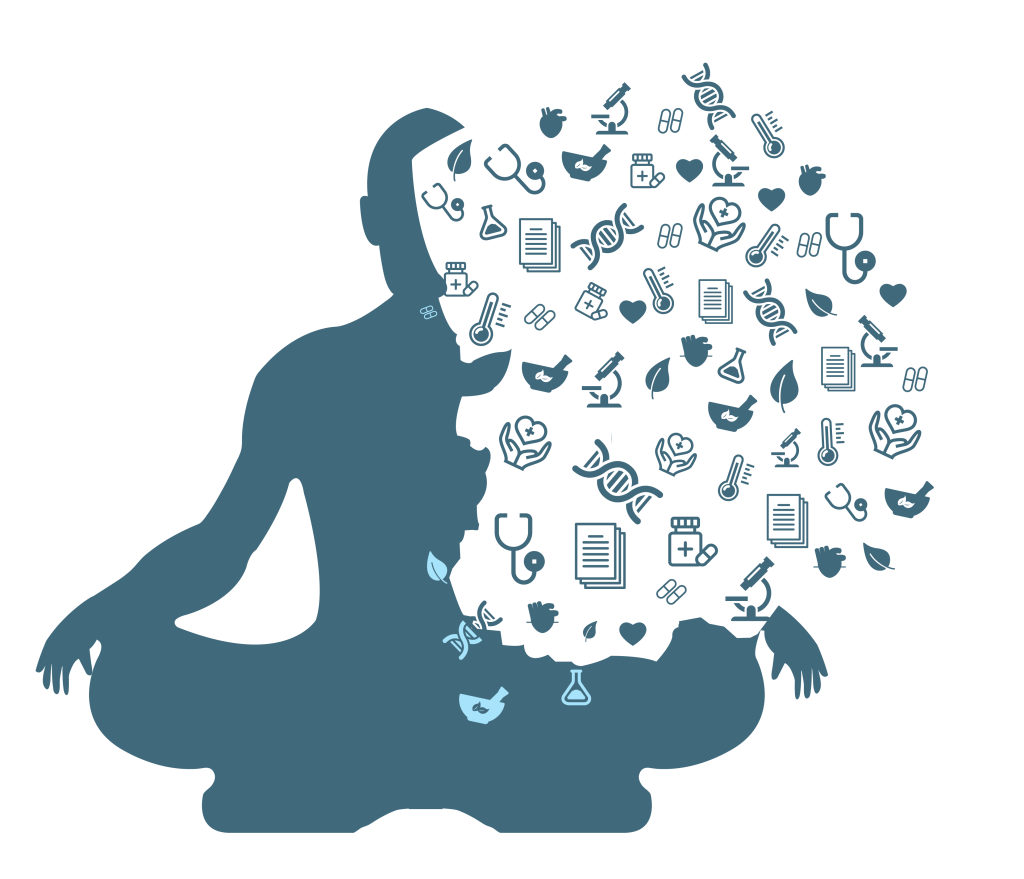
In the 1970s, brain wave studies were conducted to further understand what happens in the brain during Maharishi Mahesh Yogi’s meditation. These brain wave studies found increased EEG coherence, and research has only grown in the past 50 years. Many great scientists helped western science understand Guru Dev’s meditation which is still being studied today.
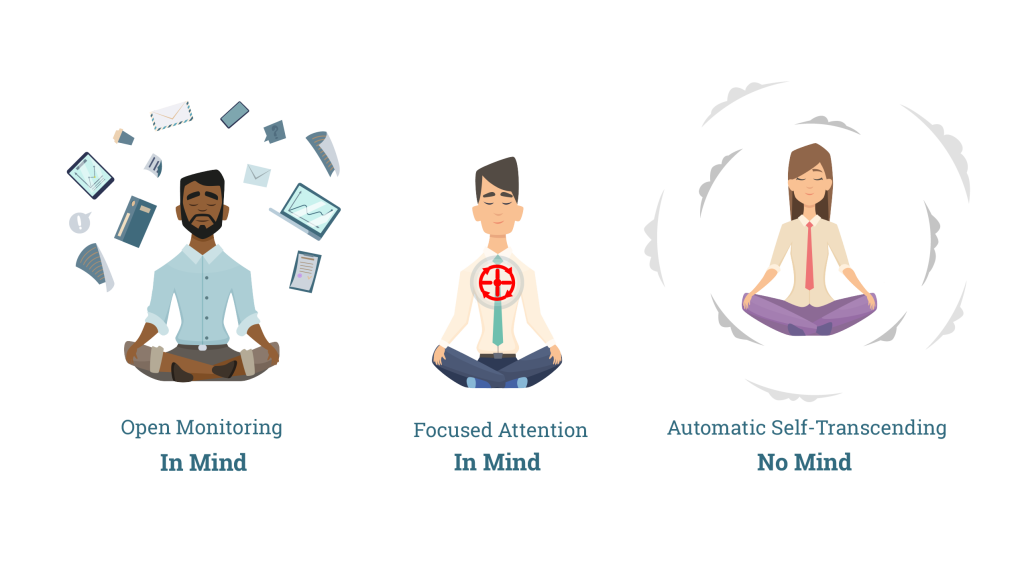
Today researchers have categorized meditations into three modalities. These modalities have their own technique, EEG signature, and even physiological response:
- Focused Attention meditation – a mindfulness technique where you actively control the mind and attention.
- Open Monitoring meditation – a mindfulness technique where you actively observe your thoughts and feelings and deliberately hold your attention.
- Automatic Self Transcending – Guru Dev’s technique that allows your mind to settle and brings you to content-free awareness or transcendental consciousness.
Automatic Self Transcending stands out from the other two modalities, as it is an effortless process, and it lets your mind naturally find content-free awareness. By controlling your attention during meditation, you are increasing your brain activity, and your mind can’t transcend.
TODAY’S METHOD OF MB-AST TIME TRACKING

MMY’s active time tracking technique stepped away from Guru Dev’s rosary time tracking method. Today’s technology has led meditators to take a step away from MMY’s active time tracking method. When a meditator has to continuously check the time of their wristwatch, it interrupts their effortless recitation of the mantra process and this inhibits their ability to transcend.
To make the experience of transcending even easier, we created a FREE guided meditation app specifically designed for Maharishi Mahesh Yogi’s Meditation or MB-AST. Our app will guide you IN and OUT of your MB-AST meditation without distracting you, and is designed so that you use the least amount of cognitive activity.
We can explain this better by looking at what happens in the brain when you meditate using Mantra Based Automatic Self Transcending (MB-AST). We can see how different time tracking methods like using rosary beads, active time tracking, or our guided app affects the brain during meditation.
The Brain & Our Perception of Reality

Do you have any idea about the importance of your brain in all stages of your life? According to Herculano-Houzel (2009), the human brain has approximately 86 billion neurons, and this number is the same for everyone. But what makes you different from everyone else if we all have the same amount of neurons? The answer is quite simple: It all depends on how our brain is connected, and how it interacts with our individual life experiences.
Did you know that the possible number of connections our brain can make is greater than the number of atoms in the entire universe? This is because of the way our neurons connect since a cell can connect and receive information from more than 10,000 other neurons. This mass amount of possible connections is what makes each individual different.
This gelatinous, and seemingly disorganized, mass we know as the brain can control our actions, and how we perceive our reality. But if we look at it from an evolutionary standpoint, our brain is the same as someone who lived in the 17th century.
For Example, since the 17th century, our world has changed immensely, and even the smallest things in our daily life look different than they did 400 years ago. Technology has made a huge evolutionary jump in the past 100 years, and it allows our brain to constantly be stimulated. This may explain the exponential increase in mental disorders such as depression and anxiety, as the amount of information we encounter every day is infinitely greater than that of someone who lived 400 years ago.
Transcendental Consciousness & Neurology of the brain during the 3 Methods
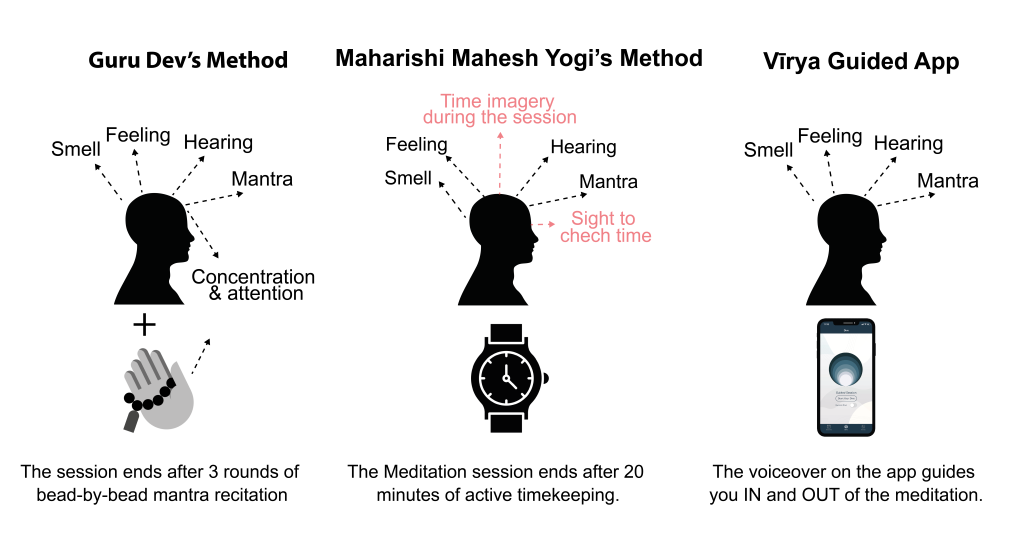
The Encyclopedia of World Problems & Human Potential describes Transcendental consciousness as: ” […] to be a fourth major state of consciousness after waking, dreaming and sleeping states. Its properties are described as empty, devoid of objects, yet wakeful, alert, categorized, and conscious of self. Four states can be described as awake/asleep, with/without objects of consciousness. If waking is awake with objects of consciousness, dreaming is asleep with objects of consciousness and deep sleep is asleep with no objects of consciousness, then transcendental consciousness is awake with no objects of consciousness. In this latter case, although wide awake, mental activity ceases as normal thought is transcended.”
This definition explains how there is a different cognitive signature in the brain when you are experiencing transcendental consciousness than when you are awake or asleep. Transcendental consciousness is considered to be awake without any object of consciousness.
Below, are three perspectives and their cerebral correlates based on the 3 methods. The red & green pathways or arrows show us the different cerebral correlates that have to be used during each of the methods.
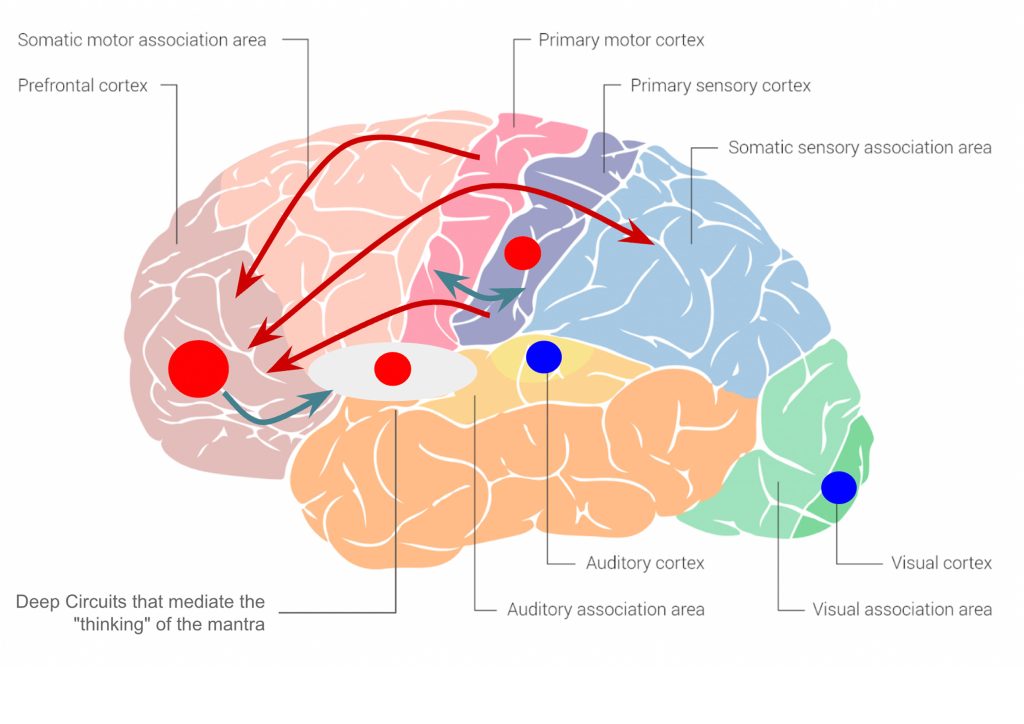
Illustration of the brain connections during the original method as taught by Guru Dev. The red and blue circles within the cortex regions depict an increase and decrease of the local activity and connectivity, respectively. The green arrows indicate the emergence of connections to execute the task during this type of meditation.
Guru Dev’s method has meditators use a 108-bead rosary to guide the mental recitation of the mantra. In the brain image above, the simple act of moving the finger to the next bead increases the connectivity of the frontal cortex with the motor and primary sensory cortex, which commands conscious finger movement and receives tactile feedback, respectively (illustrated by the pathways in green). In addition, temporal-frontal pathways that carry out the conscious processing of perceptual integration seem to aid concentration and attention during meditation with the rosary.
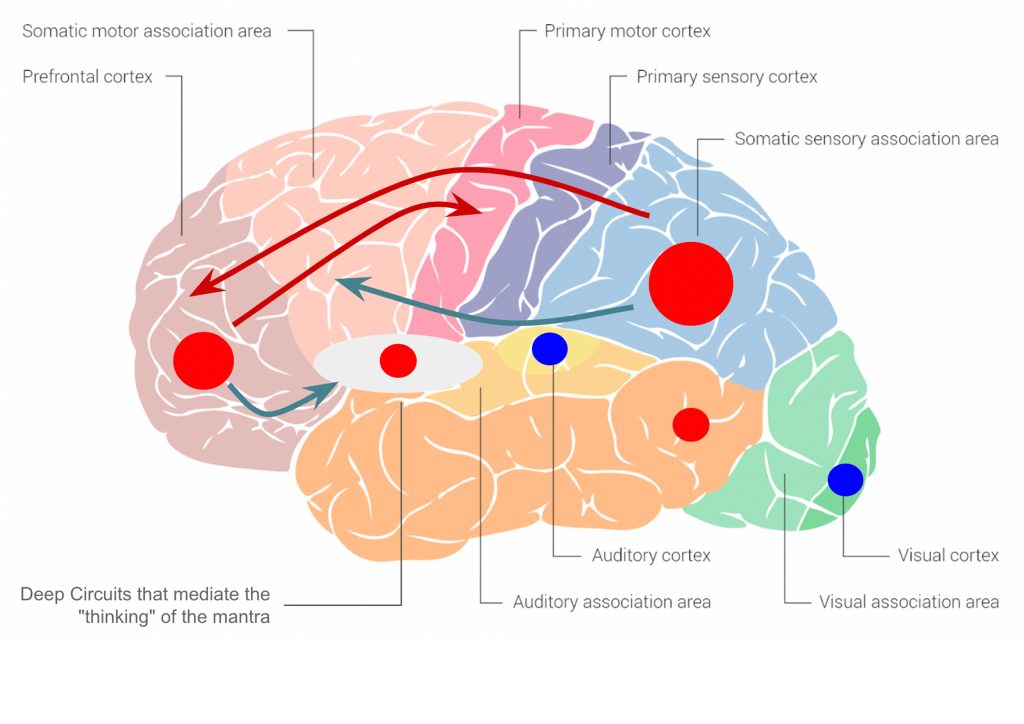
Illustration of the brain connections during the Active Time Keeping method as taught by Maharishi Mahesh Yogi. The red arrows indicate the connectivity between regions that control action behavior (such as opening the eyes to check the clock) and the internal process of time counting.
Despite its wide popularity, this method can cause distractions during meditation, because meditators need to constantly be aware of the time. They have to continuously open their eyes and check the clock. In the brain, these distractions can alter the synchrony of alpha waves located in the frontal cortex and promote increased connectivity of frontal to motor and associative ( See arrows in red in the Brain image above) regions that control the conscious movement and impair attention and concentration during the mantra.
This state of consciousness is marked by a state of alertness at rest that is completely opposite to complex behaviors such as decision making (to open the eyes, f.i.) and distractions related to active time tracking during meditation. Remember that decision-making is a completely opposite behavior to the experience of transcendental consciousness. This is because it takes the integrity of active awareness to make the decision to open your eyes and check the time during a meditation session.
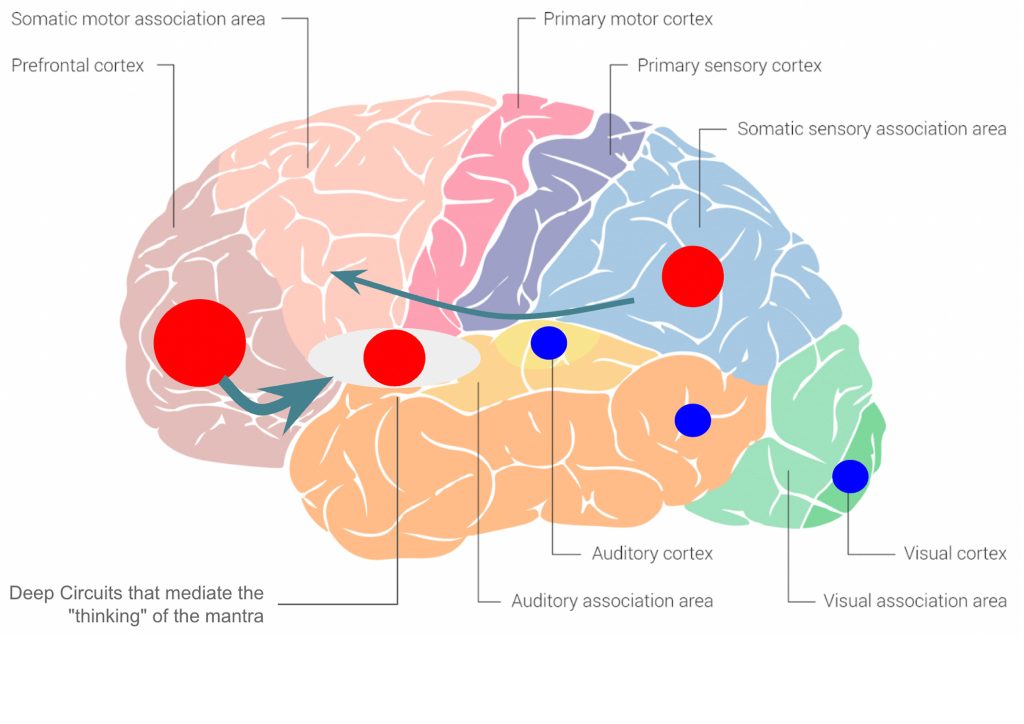
Illustration of the brain connectivity during the meditation performed on the Guided App. Note that the absence of the fronto-central and fronto-parietal circuits led to increased activation of the frontal cortex that plays an important role with the deep circuits to control (effortlessly thinking)the mantra.
By using our app, you can use the same meditation method of MMY, but without distractions. You don’t have to constantly check the time, as our app has a voice (sound stimuli) that guides you IN and OUT of the meditation, just like when you’re in a group mediation being led by a teacher.
As mentioned, the activity of mental accounting of time or the simple act of looking at the clock disrupts the fronto-central connectivity and fronto-temporal circuits (alpha and beta waves) in the brain.
The use of an app that guides the MB-AST meditation and keeps track of time eliminates distractions during the meditation and may help them transcend their mind more effortlessly. This reduces the need to open their eyes and engage in complex behaviors such as decision making which in effect does not change the synchrony of alpha waves located in the frontal cortex, and the connectivity and integration between frontal and parietal regions during the experience of transcendental consciousness.
Together, the absence of these factors that affect the connectivity of the frontal cortex can lead to greater robustness in inherent frontal connectivity (illustrated by the increased red circle in the frontal cortex in the image above) with deeper regions responsible for thinking the mantra, as well as the maintenance and facilitation of a natural transcendental consciousness experience.
OUR EEG BETA SYNCHRONY EXPERIMENT – ACTIVE TIMEKEEPING V. OUR GUIDED APP
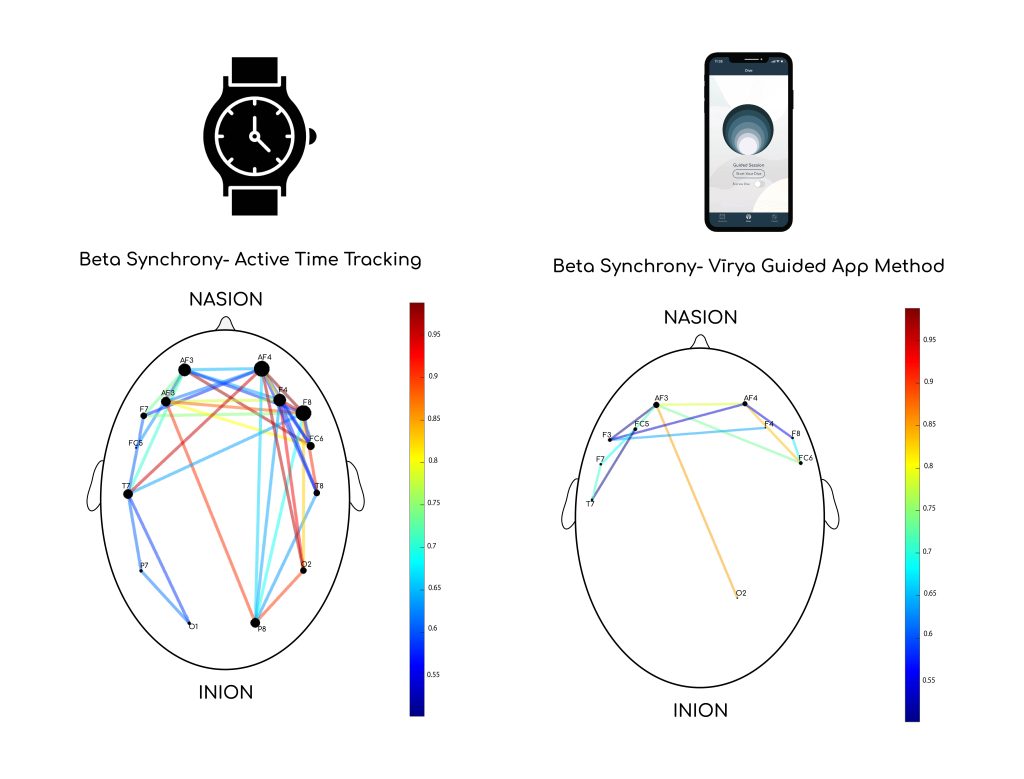
We wanted to show empirically how a unique MB-AST session performed in our app can significantly reduce the beta waves and connectivity. This connectivity was previously described as the opposite of deep relaxation and therefore the opposite of the transcendental state of consciousness.
In our experiment, we tracked their Beta waves (13- 30 Hz), which are high-frequency, low-amplitude brain waves that are commonly observed in an awakened state. They are involved in conscious thought and logical thinking and tend to have a stimulating effect.
We recorded the brain signal using an Emotiv X wireless EEG electroencephalogram with 14 electrodes distributed over the scalp. We measured the brain connectivity when MB-AST meditation was performed using the active time keeping method and with our Guided app.
In the figure above, each line in the image represents the beta wave connectivity between each electrode pair in the electroencephalogram or EEG. Our preliminary results show that a session of MB-AST with our guided app significantly reduced the beta waves during the MB-AST meditation when compared to the beta waves during the active time keeping method. Further validating that our guided app may facilitate a more relaxed experience and that a different modulation of brain network can lead to a more effortless experience during MB-AST meditation.
All three AST meditation methods can bring the meditator to experience transcendental consciousness or have a non-dual experience. However, you can effortlessly transcend the mind faster by reducing as much of the secondary cognitive activity during meditation. We know from research that any concentration during meditation will lead to an increase in cognitive activity and reduce the mind’s ability to transcend.
Discover a new way of meditating & tracking your Mantra Based Auto Self Transcending Technique using Vīrya’s FREE guided app!


